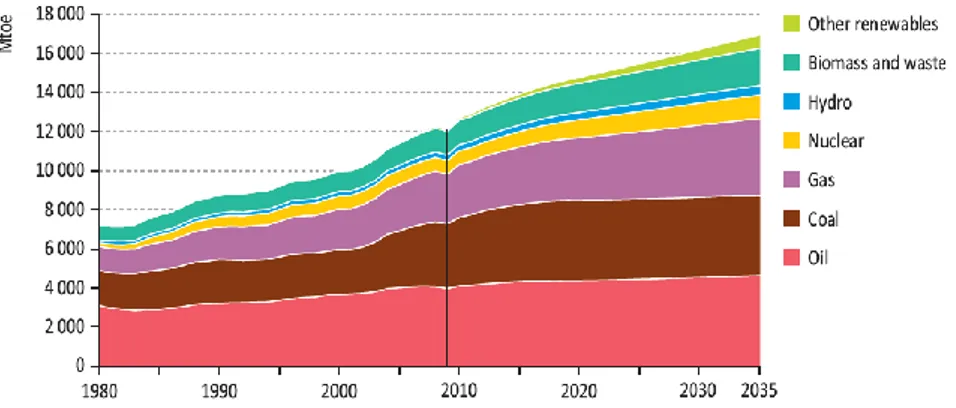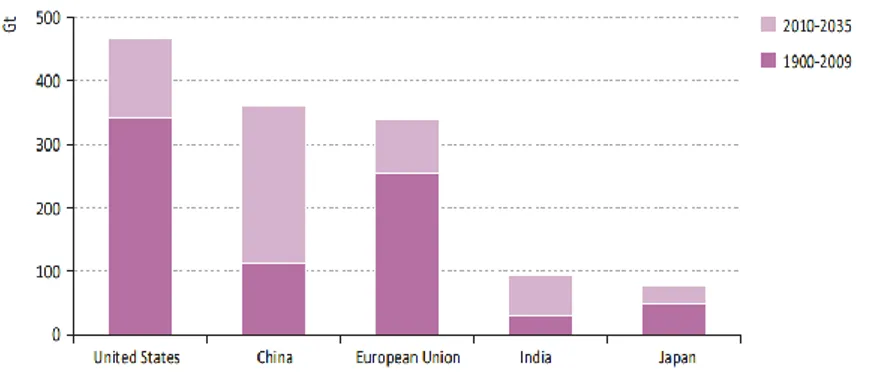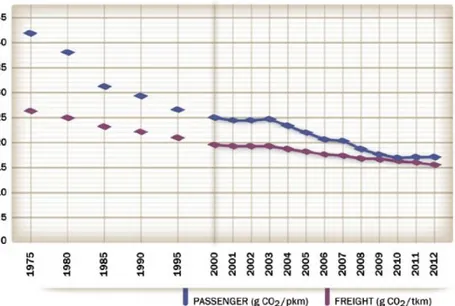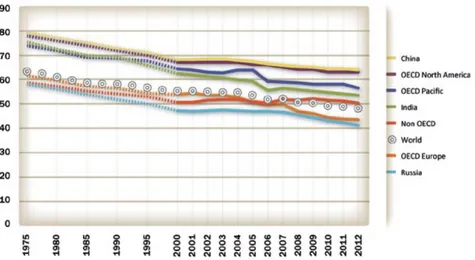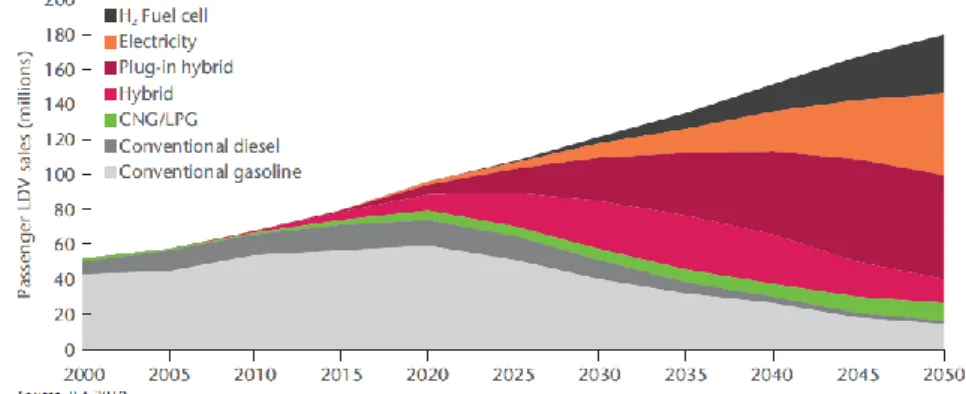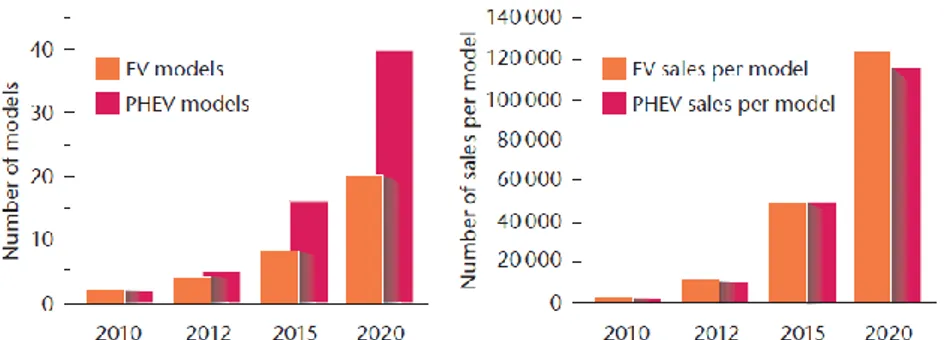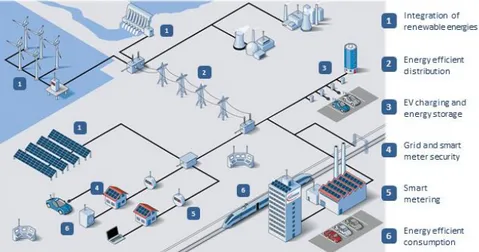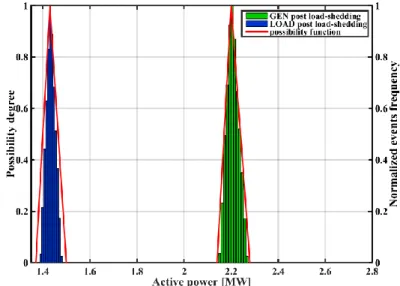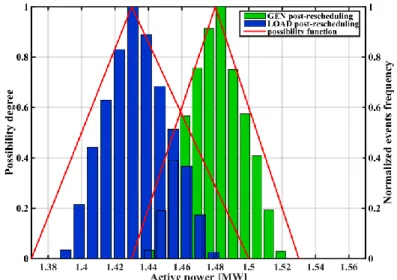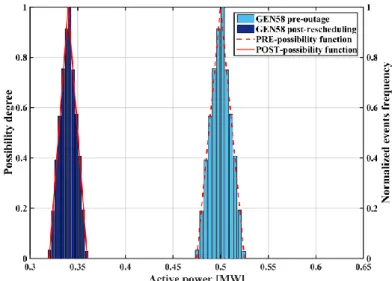Facoltà di Ingegneria
Dipartimento di Ingegneria dell'Informazione ed Elettrica e Matematica Applicata.
Dottorato di Ricerca in Ingegneria dell’Informazione XIV Ciclo - Nuova Serie
T
ESI DID
OTTORATOElectric Mobility: Smart
Transportation in
Smart Cities
C
ANDIDATO:
G
IUSEPPEG
RABERC
OORDINATORE:
P
ROF.
M
AURIZIOLONGO
R
ELATORE:
P
ROF.
V
INCENZOG
ALDIC
ORRELATORE:
D
R.
P
IERLUIGIM
ANCARELLAAnno Accademico 2014 - 2015
UNIVERSITÀ DEGLI“Our imagination is stretched to the utmost, not, as in fiction, to imagine things which are not really there, but just to comprehend those things which are there”.
Richard Feynman,
Acknowledgements
I would like to thank and dedicate my dissertation to all those who were close to me during these years. First of all, my family who was always ready to offer me so much support and encouragement.
I would like to express my sincere gratitude to prof. V. Galdi for the valuable teachings he has given me during my PhD course, and for the care with which I was constantly followed in every step of my work.
I especially thank Dr. P. Mancarella for his willingness to support me in the realization of this PhD dissertation.
Finally, warm thanks to my mates in the S.I.S.T.E.M.I. lab. and to the colleagues of the PhD program in Information Engineering with I shared these years, cause they made this period of my life an experience I will never forget and it will be always one of my dearest memories.
Fisciano, 05/03/2016
Table of Contents
Acknowledgements ... VI Table of Contents ... VIII List of Acronyms... XII
Introduction ... 2
Chapter 1 - Transport Systems in the Smart Cities of the Future . 6 1.1 Energy Demand in Transport Sector ... 7
1.2 Transport Systems for Sustainable Mobility ... 12
1.2.1 Electrification of Urban Transport ... 14
1.3 Tram, Metro and Light Railway Systems... 16
1.3.1 Sustainability in Electrified Transport Systems ... 19
1.4 E-Mobility: Electric Vehicles Future Penetration ... 21
1.4.1 Market Growth & CO2 Reduction ... 22
1.5 Sustainable Transportation into Modern Power Systems ... 26
References ... 31
Chapter 2 - Smart Grids: Power Systems in Smart Cities ... 34
2.1 The Smart Grid Concept ... 35
2.1.1 The Smart Grid Technologies... 38
2.2 Reliability in Smart Grids ... 40
2.2.1 Resiliency of Smart Grid Functions ... 42
2.3 Overloading and Outages: what to do ... 44
2.3.1 Scheduling of Generators ... 45
2.3.2 Load Shedding ... 47
2.4 Uncertainty in Power Systems... 49
2.4.1 Possibility Theory ... 49
2.4.2 Fuzzy Numbers ... 51
2.5 GRLS Problem under Uncertainty Conditions ... 54
2.5.1 Mathematical Formulation ... 55
2.5.1.1 Rescheduling Problem ... 56
2.5.1.2 Load Shedding Problem ... 57
2.6 Simulation Framework ... 61
2.6.1 Case Study ... 61
2.6.2 Numerical Results... 63
References ... 67
Chapter 3 - EVs in Smart Grid: a Smart Charging Solution ... 70
3.1 Electric Vehicles Technology ... 71
3.2.1 EVs Charging Options ... 74
3.2 Factors Affecting EVs Charging Demand ... 78
3.3 EVs Charging Profile Prediction ... 81
3.4 Vehicle Usage Data Analysis ... 83
3.4.1 Data Acquisition: COSMO Research Project ... 84
3.4.2 Data Clustering ... 85
3.5 EVs Charging Scheduling Algorithm ... 86
3.5.1 Mathematical Formulation ... 88
3.5.1.1 Charging Modes ... 89
3.5.1.2 Optimized EVs Scheduling Problem ... 90
3.5.2 Solution Algorithm ... 91
3.5.3 Scheduler Architecture and Protocol ... 93
3.6 Simulation Framework ... 95
3.6.1 Case Study ... 95
3.6.2 Numerical Results ... 97
3.6.2.1 Data Clustering Results ... 97
3.6.2.2 Scheduled EV Charging Results ... 101
References ... 106
Chapter 4 - Energy Efficiency in Metro Systems ... 110
4.1 Innovative Solution for Energy Efficiency ... 111
4.1.1 Energy Storage Systems ... 114
4.1.2 Eco Drive Speed Profiles ... 117
4.2 Models of the Metro Systems ... 120
4.2.1 Metro Vehicle ... 120
4.2.2 Energy Storage System ... 122
4.2.2.1 Power Converter Control Algorithm ... 123
4.2.3 Feeding Network ... 125
4.3 ESSs Sizing and Positioning Problem ... 127
4.3.1 Mathematical Formulation ... 127
4.3.2 Solution Algorithm ... 129
4.4 Eco-Drive Speed Profiles Problem ... 131
4.4.1 Mathematical Formulation ... 131
X Table of Contents
4.5 Simulation Framework ... 136
4.5.1 Case Study ... 136
4.5.2 Numerical Results ... 137
4.5.2.1 SCs Positioning and Sizing Results ... 138
4.5.2.2 Eco-Drive Speed Profiles Results ... 142
References ... 147
Chapter 5 - Conclusions ... 150
5.1 Summary of Dissertation ... 150
List of Acronyms
AC Alternate Current
BEV Battery Electric Vehicle
BP British Petroleum
CF Control Function
CHP Combined Heat and Power
CS Charging Station
DAS Driver Advisory System
DC Direct Current
DCFC Direct Current Fast Charge
DER Distributed Energy Resource
DG Distributed Generation
DSM Demand Side Management
DN Distribution Network
DPO Dynamic Programming Optimization
EIA U.S. Energy Information Administration
ESS Energy Storage System
EV Electric Vehicle
EVSE Electric Vehicle Supply Equipment
FCEV Fuel Cell Electric Vehicle
FS Ferrovie dello Stato Italiane
GA Genetic Algorithm
GHG GreenHouse Gas emission
GRLS Generation Rescheduling and Load Shedding
GTO Gate Turn-Off thyristor
HEV Hybrid Electric Vehicle
HTSC High Temperature Superconductors
ICE Internal Combustion Engines
ICT Information and Communication Technology
IEA International Energy Agency
IEEE Institute of Electrical and Electronics Engineers
LDV Low Duty Vehicle
LV Low Voltage
μG Microgrid
MEMS Microgrid Energy Management System
MILP Mixed Integer Linear Programming
MINLP Mixed Integer Non-Linear Programming
MV Medium Voltage
nec Necessity
OECD Organisation for Economic Co-operation and
Development
PCC Point of Common Coupling
pdf Probability Density Function
PEV Plug-in Electric Vehicle
PHEV Plug in Hybrid Electric Vehicle
pos Possibility
PSO Particle Swarm Optimization
PV Photovoltaic
R&D Research and Development
RES Renewable Energy Source
RPS Railway Power System
SoC State of Charge
SC Supercapacitor
SG Smart Grid
T&D Transmission & Distribution
ToU Time of Use
UIC International Union of Railways
UniSA University of Salerno
VOC Volatile Organic Compounds
V2G Vehicle-to-Grid
V2I Vehicle-to-Infrastructure
V2V Vehicle-to-Vehicle
Introduction
One of the mega trends over the past century has been humanity’s move towards cities. As many as 60% of the world’s population will live in cities by the year 2030, according to the World Health Organization, and this rapid urbanization is putting unprecedented pressure on city infrastructures, services and the environment. Public Administration and Municipalities are facing a challenging task, to harmonize a sustainable urban development offering to people in city the best living conditions.
The growing phenomenon of Smart Cities has led city managers and planners to look beyond traditional approach in city planning, finding ways to give to the people a place where to live that is environmentally, economically and socially sustainable. Smart city is now considered a winning urban strategy able to increase the quality of life by using technology in urban space, both improving the environmental quality and delivering better services to the citizens.
Mobility is a key element to support this new approach in the growth of the cities. In fact, transport produces several negative impacts and problems for the quality of life in cities, such as, pollution, traffic and congestion, with a negative impact on the quality of life in cities. Therefore, Sustainable Mobility is one of the most promising topics in smart city, as it could produce high benefits for the quality of life of almost all the city stakeholders.
Sustainable Mobility is not a unique initiative, but a complex set of projects and actions, different in goals, contents and technology intensity.
The boldest and imminent challenge awaiting mobility in smart cities is the introduction of the electricity as energy vector instead of fossil fuels, concerning both the collective and the private transports.
Public transport is a very important aspect for a sustainable mobility in urban areas, and it considered one of the most relevant approach to encourage low-carbon growth in cities. Electric public
transport include electric city buses, trolleybuses, trams (or light rail), passenger trains and rapid transit (metro/subways/undergrounds, etc.). Even though railway systems are the most energy efficient than other transport modes, the enhancement of energy efficiency is an important issue to reduce their contributions to climate change further as well as to save and enlarge competition advantages involved. One key means for improving energy efficiency is to deploy advanced systems and innovative technologies. Therefore, the International Union of Railways is funding several research projects aimed to evaluate the current railway energy saving methodologies.
Additionally, electrification of the private road transport has emerged as a trend to support energy efficiency and CO2 emissions
reduction targets. According to the International Energy Agency (IEA), in order to limit average global temperature increases to 2°C - the critical threshold that scientists say will prevent dangerous climate change -, by 2050, 21% of carbon reductions must come from the transport sector. To achieve this goal, the agency says, three fourths of all vehicles sold by 2050 need to be electric, including plug-in hybrid and battery electric vehicles (EVs).
In recent years, many EVs were announced and many prototypes presented. Today, there are more than 20 models offered by different brands covering different range of sizes, styles, prices and powertrains to suit the wider range of consumers as possible. Full EVs uses electric motor and battery energy for propulsion, which has higher efficiency and lower operating cost compared to the conventional internal combustion engine vehicle. The continuous development of lithium ion battery and of fast charging technology will be the major facilitators for EVs roll out in the very near future. However, the present EVs industry meets many technical limitations, such as high initial price, long battery recharge time, limited charging facilities and driving range.
Although it is desirable a fast development from the start of electric mobility, its impact on the existing power grid must be assessed beforehand to see if it is necessary prior an adjustment of power infrastructure or/and the introduction of new services in the power grid. In fact, the interconnection of EVs on the power grid for charging their batteries potentially introduces negative impacts on grid operation: uncontrolled charging can significantly increase average load in the existing power systems, with problems in terms of
4 Introduction reliability and overloads. If uncontrolled EV charging is added to the system, this can have effects both at the distribution and at the generation level. In countries with an advanced development of the distribution grid, no significant risks for distribution or transmission grids could be identified even for high shares of electric vehicles, as long as charging uses low power (household) connections. In countries with relatively weak electricity infrastructure, however, even small-scale EV introduction can cause local power-outages if charging is uncontrolled.
Controlled or smart charging will allow a much greater number of cars in the cities, avoiding local overload and allowing a faster EVs penetration without requiring an imminent improvement of the electricity generating and grid capacity. This results in considerable potential benefit for smart charging, possibly through price incentives such as dynamic tariffs, in order to cut off peak demand and smooth electricity demand curves. Smart charging might also allow load balancing both at sub-station and at the grid level, particularly with charging at peak wind supply times. This kind of use of EV battery capacity for storing electric energy may ease the integration of large scale intermittent electricity sources such as renewable energy sources (RESs).
The proposed PhD Dissertation is developed in the context just described, mainly focusing the attention on the impact that electric mobility will have on the power systems and the effectiveness of solutions aimed to increase the reliability and resilience in the smart grid. In particular, it is addressed a scenario analysis regarding the electric vehicles charging management and some innovative solutions to increase energy efficiency in electrified transport systems. The first chapter emphasizes on the key aspects related to the sustainable mobility in the smart cities of the future. It provides a brief overview on the transport sector energy consumption expected in the next years. In particular, the chapter shows the significant contribution that the electrification of urban transport may provide to the sustainable mobility, and the serious concerns related to its impact on existing power systems.
Chapter 2 proposes a solution method for an optimal generation rescheduling and load-shedding (GRLS) problem in microgrids in order to determine a stable equilibrium state following unexpected
outages of generation or sudden increase in demand. The chapter mainly focuses on the mathematical formulation of the GRLS problem and the proposed solution algorithm. Finally, simulations results carried out by using a real case study data are presented and discussed. In Chapter 3, a simple and effective methodology is proposed to analyze data acquired during the fulfillment of the COSMO research project, and to identify typical load pattern for the EVs charging. The chapter also presents a novel scheduling problem formulation, flattening the demand load profile and minimizing the EVs charging costs, according to the electricity prices during the day. Finally, some simulations results are discussed, showing the effectiveness of the proposed methodology. Chapter 4 introduces some innovative solutions for energy efficiency in urban railway systems focusing, in particular, on energy storage systems and eco-drive operations in metro networks. The mathematical formulation of these optimization problems and the proposed solution algorithms are illustrated and discussed. The obtained results are part of the activity carried out in the SFERE research project. Finally, Chapter 5 ends the Dissertation with some concluding remarks and further developments of the proposed research activity.
Chapter 1
Transport Systems in the Smart Cities
of the Future
Urbanization is accelerating at pace, placing new intense pressures on city resources and infrastructure. Urban mobility will be one of the toughest challenges for cities around the globe. In many cities, existing mobility systems are already inadequate and, thus, urbanization and increasing populations will increase demand still further. Cities traditionally searched to solve such challenges by adding new capacity to match demand. However, a capacity-building approach alone is neither efficient nor sustainable.
A smart city is an efficient and livable city, as well as an economically, socially and environmentally sustainable city. This vision can be realized in the next future integrating the different mobility solutions (rail, automotive, bicycle and walking) into one convenient, easily accessible, time-efficient, affordable, safe and green. An integrated systems approach optimizes infrastructure and energy consumption and provides transportation for city residents exactly where and when they need it.
The electrification of road transport establishes a link between the energy and mobility sectors as well as a new domain of services in regards to the management of electric mobility as for the first time it brings together utilities and grid operators. The deployment of electric vehicles in the network will require the provision of the supporting infrastructure and systems, and their integration in the full mobility system in a wide scale. The rail public transport, that uses electric energy, provides a sustainable mobility solution as well and will growingly be an alternative to private vehicles in the future. Given the
limitations of the electric vehicle, its intelligent integration into the existing urban transport infrastructure is essential.
This chapter emphasizes on the key aspects and problems related to the electrification of urban transport for sustainable mobility in the smart cities of the future. The purpose of Section 1.1 is to provide a brief overview on the current transportation energy consumption and expected scenarios in the coming years for transport demand. Developing transport systems that are environmentally friendly and characterized by high energy efficiency values is a prerequisite for sustainable mobility and they are illustrated in Section 1.2. However, Section 1.3 shows the significant contribution that the electrified transport systems may provide to the sustainable mobility, whereas Section 1.4 deals with electric vehicles and their growing penetration in the current car market. Finally, Section 1.5 discusses the impact on existing power systems of the urban transport electrification in smart cities.
1.1 Energy Demand in Transport Sector
In the New Policies Scenario, in which recent government policy commitments are assumed to be implemented in a cautious manner, demand increases for all energy sources over the 2035 period, but the pace and trend varies, [1].
Figure 1 - World primary energy demand by fuel in the New Policies Scenario (source: IEA, WEO-2011).
8 Chapter 1 - Transport Systems in the Smart Cities of the Future Around 2000, the transport sector crossed a threshold to account for more than half of total oil demand and it has not looked back. The projected share of the transport sector continues to increase from 55% today to more than 60% in 2040, despite increased fuel efficiency and the growth of alternative fuels. More than three quarters of transport oil demand comes from road transport today, as share which is set to remain broadly unchanged until 2040, [2]. Although aviation is the fastest growing of all transport sectors, road transport is set to account for over two-thirds of oil demand growth for transport. The growth in oil demand for transport occurs almost exclusively in emerging and developing countries, whereas in OECD countries the oil demand of the transport declines across all sub-sectors, except aviation, [3].
In the New Policies Scenario, global demand for oil increases from 84 million barrels per day (mb/d) in 2009 (almost 87 mb/d in 2010) to 99 mb/d in 2035 (Figure 1). All of the net growth in global oil demand in the New Policies Scenario comes from the transport sector in the non-OECD countries, growth being particularly strong in India, China and the Middle East.
Figure 2 - Total final consumption by sector in the New Policies Scenario, 2040 (source: IEA, KWES-2015).
From the energy point of view, the transport sector currently counts for almost 30% of global final energy consumption (Figure 2), including all modes of transportation, from personal vehicles (cars, light trucks) to public transportation (buses, trains) and airplanes, from freight trains to barges, [4].
One might think that airplanes, trains, and buses would consume most of the energy used in this sector but, in fact, their percentages are relatively small-about 9% for aircraft and about 2% for trains and
buses. As reported in Figure 3, personal vehicles, in fact, consume 57% of the energy used for transportation, [5].
Figure 3 - Transportation energy use by mode (source: U.S. EIA, IEO-2014).
The number of vehicles on the world’s roads doubles between 2012 and 2040, but the increasingly widespread adoption of vehicle fuel-economy standards mitigates the expected impact on transport demand, which rises on average by 1.2% per year - a significantly slower pace than in recent decades, [3].
Figure 4 - Change in energy demand by sector and region in the New Policies Scenario, 2012-2040 (source: IEA, WEO-2014).
All of the growth in transport demand comes from non-OECD countries, notably China; it declines in the OECD, where efficiency gains more than outweigh a modest expansion of the vehicle fleet (Figure 4). Oil-based fuels continue to dominate transport energy demand, although alternative fuels, diesel demand grows strongest and diesel overtakes gasoline as the dominant oil product in the transport
10 Chapter 1 - Transport Systems in the Smart Cities of the Future sector by mid-2030s, [3]. While oil still accounts for 85% of total transport demand in 2040, this is a lower share than today’s 93%, as alternative fuels, such as natural gas, biofuels and electricity, gain ground. The deployment of alternative fuels is higher in OECD countries, where they account for more than 20% of total transport demand by the end of projection period, [3].
Without the impact of fuel switching and efficiency gains, the increase in oil demand implied by our projections (e.g. from increased vehicle ownership and rising industrial activity) would result in an increase in consumption of 53 mb/d by 2040 (Figure 5). Nevertheless, this - purely theoretical - increase is moderated in practice by the switch to alternative fuels (that determines a reduction of 17 mb/d) and by the adoption of more efficient technologies (that determines a reduction of 23 mb/d). In the New Policies Scenario, energy efficiency has a stronger impact on moderating oil demand growth than fuel switching in transport, while fuel switching plays a more important role in power generation and buildings, [6].
Figure 5 - Impact of fuel switching and efficiency on the change in global oil demand by sector in the New Policies Scenario, 2013-2040,
(source: IEA, WEO-2014).
The strong use of fossil fuel results in a very strong impact in terms of greenhouse gas emissions: in the EU-28 in 2011, transport is responsible for around 20% of greenhouse gas (GHG) emissions making it the second largest GHG emitting sector after the energy industry. In addition, despite the fact that emissions from other sectors (energy industry, manufacturing, etc.) present a general decreasing
trend, those from transport have increased by 19% from 1990 to 2011. Emissions from the transport sector showed a continuous growth between 1990 and 2007; followed by a slight dip (-6%) between 2007 and 2011. However, this downward trend is considered to be mainly due to the economic recession.
Figure 6 - EU-28 GHG emissions of the transport sector (source: Eurostat Pocketbook, 2013).
Over the 1990-2011 period, emissions from road transport and civil aviation grew by 21% and 17% respectively, while emissions from domestic maritime transport presented a 1% growth (Figure 6). In contrast, emissions from railway transportation fell by 46%. A breakdown by sector shows that road transport has dominated emissions from this sector throughout this period (94% in 2011), [7].
Figure 7 - Cumulative energy-related CO2 emissions in selected countries and
regions, 1900-2035 (source: IEA, WEO-2011).
As reported in Figure 7, energy-related CO2 emissions are expected
12 Chapter 1 - Transport Systems in the Smart Cities of the Future in power generation, where emissions increase by 2.3 Gt, and transport, where emissions increase by 2.1 Gt. These two sectors combined account for almost 75% of the increase in energy-related emissions.
1.2 Transport Systems for Sustainable Mobility
People need to move around to secure basic human needs, but mobility is also a luxury, contributing to quality of life by enabling exploration, leisure and recreation. In the city, high quality mobility is a necessity for the success of other urban sectors, the creation of jobs, and plays a key role in cultivating an attractive environment for residents and business. The combined influence of population growth, demographic change and changing urban form leads to increasing demand for travel in city centers, suburbs and between the two. Demand for improved intercity mobility is also growing, to create faster and effective connectivity between settlements. As urban populations increase, existing and emerging cities face the challenge of meeting rising demands for efficient mobility within limited physical infrastructure capacity. As demand rises, so too do concerns about transportation as one of the leading contributors to global greenhouse gas emissions, congestion, noise and poor air quality in cities. Indeed, urban mobility is widely cited as one of the universal challenges faced by cities the world over, [8].
This growing demand converges with an inadequate supply of physical transport capacity in many cities, which can result in crowding, congestion, and an unpleasant experience of the city. In established cities, this problem is attributed to spatial constraints - which inhibit additional growth of transport networks - together with economic limitations on physical infrastructure maintenance and renewal. Meanwhile, in many developing cities the investments in infrastructure constructions are struggling to keep pace with the rapid rate of urban growth, [9].
Sustainable development meets the needs of the present generation without compromising the ability of future generations to meet their own needs. Thus, a sustainable transportation system allows the basic access and development needs of individuals, companies and society
to be met safely and in a consistent way with human and ecosystem health, and promotes equity within and between future generations. It is affordable, operates fairly and efficiently, offers a choice of transport mode, and supports a competitive economy, as well as balanced regional development. Sustainable mobility, also, limits emissions and waste within the planet’s ability to absorb them, uses renewable resources at or below their rates of generation, and uses non-renewable resources at or below the rates of development of renewable substitutes, while minimising the impact of the use of land and the generation of noise.
Figure 8 - The challenges of making mobility sustainable (source: WBCSD - 2004).
Figure 8 illustrates both the aspects of sustainable mobility - its benefits and its costs - as well as some of the relationships characterizing them - at least until the present. It also reveals points of leverage that, if exploited, can modify some of these relationships in ways that enhance mobility’s benefits and reduce its costs. First, transport services can be made more efficient, increasing the amount of economic growth supported by a given volume of transport services. Second, the level and composition of “induced” mobility demand can be channeled in ways that fulfill growing mobility needs but create fewer transport impacts. Third, the level of adverse economic and environmental impacts associated with any given level
14 Chapter 1 - Transport Systems in the Smart Cities of the Future of transport activity can be greatly reduced through significant technology shifts, [8].
1.2.1 Electrification of Urban Transport
In the context of sustainable mobility, transportation electrification is an ideal way to cut down the air pollution while reducing the dependence on fossil fuels. In urban areas in particular, the electric carrier in urban transport can reduce air pollution in the cities, especially when it comes to local pollutants such as particulates, NOx,
SOx, VOCs and ozone. The use of electric buses, trains and light trains
can drastically improve the air quality, traffic congestion and noise pollution. Existing electrified transport systems represent an interesting option for governments seeking to increase mobility and choice for commuters. It is an efficient, high-capacity transport mode that can effectively co-exist with other forms of public transport.
Urban public transport systems powered by electricity can trace their origins to 1879 when Berlin launched the world’s first electric suburban railway (S-Bahn), followed by electric trams in 1881 and electric trolleybuses a year later. Electric drivetrains are more efficient than the conventional ones due to their high-energy conversion efficiency. They also do not consume energy while at rest or coasting, and some of the energy lost when braking can be captured and used again: in fact, through regenerative braking it is possible capturing as much as one fifth of the energy normally lost during braking, [10].
Electric buses, which require neither great range nor speed and can be partially charged during their journeys as they stop for passengers, are seen as the most promising area for potential growth of green urban public transport. China is the world leader in developing battery electric buses. The southern city of Shenzhen has the world’s largest zero-carbon fleet of all-electric buses and taxis, and plans to have 6000 electric buses in service by 2015, [11]. Trolleybuses are electric buses that use spring-loaded trolley poles to draw their electricity from overhead lines, generally suspended from roadside posts, as distinct from other electric buses that rely on batteries. Because they do not require tracks or rails, they are more flexible than trams and drivers can cross the bus lane, making the installation of a trolleybus system much cheaper.
In the 1960s, the tram saw a decline in favour of diesel driven buses, but the backlash in recent years against pollution and dependence on fossil fuels has seen a resurgence of interest in electric trams as another urban transport system that can carry large numbers of passengers efficiently without generating emissions at the point of use. Tram systems do not need vast financing compared with underground systems, which are typically four times more expensive to construct. However, in addition to its relative high cost, compared to that of buses or trolleybuses, the greatest disadvantage of the tram is its confinement to a set route by the wires and tracks it requires. The largest tram networks are in Melbourne, St Petersburg, Vienna, Berlin, Milan, Toronto, Budapest, Bucharest and Prague, while many cities in North America are exploring or planning tram systems, [11].
Market growth is mainly driven by new metro and electric light rail urban transport projects under way on most continents, from major cities in Asia and the Persian Gulf to North and South Africa and North American urban areas. A metro rapid transit system is an electric passenger railway in an urban area with a high capacity and frequency, typically located either in underground tunnels or on elevated rails above street level. It allows higher capacity with less land use, less environmental impact and a lower cost than typical light rail systems. Light rail systems use small electric-powered trains or trams that generally have a lower capacity and lower speed than normal trains to serve large metropolitan areas. They usually operate at ground level, but can include underground or overhead zones, [9].
With transport systems estimated to account for between 20% and
25% of world energy consumption and CO2 (carbon dioxide)
emissions, electric vehicles offer greater efficiency than their conventional counterparts, [3]. Several European countries, as well as the US, Japan, China and others, have recently announced bold plans for the introduction of electric vehicles. These include fiscal incentives, funding research on batteries and electric vehicles and plans for the deployment of a charging infrastructure. Major cities, such as London and Paris, have announced electric car-sharing systems, while public administrations and companies using large captive fleets are purchasing electric vehicles.
During operation, the energy efficiency of electric vehicles is much higher than that of conventional cars and they do not emit any CO2 or
16 Chapter 1 - Transport Systems in the Smart Cities of the Future and reduced noise are major advantages of electricity as a fuel. In particular, electric vehicle ‘tank-to-wheels’ efficiency is a factor of about 3 higher than internal combustion engine vehicles.
There are now four types of electric cars: battery electric vehicles (BEV), plug-in hybrid electric vehicles (PHEV), conventional hybrids electric vehicles (HEV) and hydrogen fuel cell powered (FCEV). BEVs runs entirely on a battery and electric drive train, without a conventional internal combustion engine. These vehicles must be plugged into an external source of electricity to charge their batteries. Plug-in hybrid vehicles run mostly on batteries that are charged by plugging into the power grid. They are also equipped with an internal combustion engine that can charge the battery and/or to replace the electric drive train when the battery is low and more power is required. Because PHEVs can be charges on the public network, they are often cheaper to run than tradition hybrids though the amount of savings depend on the distance driven on the electric motor alone, [12]. HEVs on the road today have two complementary drive systems: a gasoline engine and fuel tank and an electric motor, battery and controls. The engine and the motor can simultaneously turn the transmission, which powers the wheels. HEVs cannot be charged from the power grid. Their energy comes entirely from gasoline and regenerative braking. Finally, FCEVs are another type of electric vehicle expected to be widespread on the market in the next few years. Instead of storing and releasing energy like a battery, fuel-cell electric vehicles create electricity from the chemical reaction between hydrogen and oxygen that happen in the FC. Because of these vehicles’ efficiency and water-only emissions, some experts consider these cars to be the best electric vehicles, even though they are still in development phases.
1.3 Tram, Metro and Light Railway Systems
Urban congestion has focused attention on the need for improved public transportation. Many cities worldwide are recognizing that trams and light rail systems are effective in transporting large volumes of commuters efficiently and without detriment to the environment. As a result, transport authorities are opting either to restore their
existing light rail infrastructure or to construct complete new systems from scratch. Railway systems offering excellent economics, environmental performance, and punctuality are recognized as a core element of smart city development. Together with the pursuit of efficiency, safety, reliability, and energy savings, the concepts likely to prove key to the future of railways systems include making railways into a more attractive service business, [13]. The adoption of advanced information systems in stations, trains, as well as in the passenger’s smartphone and other railway industry applications will help reduce the distance between public transport and private mobility perceived by users, even more encouraging their development in smart cities. At the United Nations Climate Change Summit in 2014, UIC (International Union of Railways) has presented the “Low Carbon Rail Transport Challenge”, aimed to promote railway transport as a sustainable alternative to other modes of transportation with higher carbon intensity, such as road or aviation. The three main targets of UIC for world railways are to improve efficiency, to decarbonize power and to achieve a more sustainable balance of transport modes. In order to reach those goals, railways are developing the electrification of the infrastructure, improving load factors, procuring more efficient rolling stock, developing energy and traffic management systems and efficient driving, [13].
The key figures in the 2012 statistics shows the global contribution of rail to energy use and CO2 emissions: railway systems were
responsible for 0.6% of global energy consumption and less than 1% of global CO2 emissions, while an energy share of 21% and a CO2
share of 17% can be attributed to road transport, [13]. Even accounting for the much higher share of passengers transported by road versus by rail, the difference between road and rail energy use and emissions is striking. The rail sector’s energy intensity has declined globally since 1975, achieving in 2012 about half of its original 1975 level for passenger and freight transport (Figure 9). Not only energy intensity has been improving, but the energy sources used in rail have also become cleaner since 1990, with the progressive phasing out of coal and the growing electrification of the sector, enhanced by the growing share of renewable electricity used in rail. This resulted in a drop in specific CO2 emissions close to 60% for
18 Chapter 1 - Transport Systems in the Smart Cities of the Future
Figure 9 - Railway specific energy consumption, 1975-2012 (source: EIA, RH-2015).
Figure 10 - Railway specific CO2 emissions, 1975-2012
(source: EIA, RH-2015).
UIC sets internal targets to reduce specific final energy consumption (50% by 2030 and 60% by 2050) and specific average
CO2 emissions from train operations (50% by 2030 and 75% by
2050), all relative to a 1990 baseline. UIC has also launched a “Modal Shift Challenge”, calling for investments that will increase the modal share of railways at the expense of high carbon transport. The target is increase the rail share of passenger transport up to 50% by 2030 and up to 100% by 2050, relative to a 2010 baseline; and for the rail share of freight land transport to be equal with road by 2030 and 50% greater than road by 2050, [13].
1.3.1 Sustainability in Electrified Transport Systems
As part of a wider industry and government agenda for sustainability and energy savings, the way in which the railway industry consumes energy has been researched. Enhancing energy efficiency enables the dual benefits of improving the economics of railway operators and of reducing GHG emissions (Figure 11). However, considering the energy efficiency opportunities available in the existing infrastructure and the upcoming expansion, there is immense scope to learn, adopt and upscale use of innovative energy efficiency technologies, solutions and best practices, [13].
Figure 11 - Evolution of electric intensity for passenger rail in selected countries and geographic areas, 1975-2012 (MJ/train-km)
(source: EIA, RH-2015).
The railway sector is considering or has already implemented several technological solutions that will facilitate energy efficiency
20 Chapter 1 - Transport Systems in the Smart Cities of the Future improvements in the next decades, such as installing energy meters, recovering energy from braking, implementing Driver Advisory Systems (DAS) or leveraging on better infrastructure management. An increasing number of trains are being equipped with technology to recover electric energy from braking, [14].
The energy recovered can be used both internally to the train for the operation of auxiliary systems (e.g. to power lights, air conditioning, door opening and closing, or to charge a battery for later usage when possible) and externally. The recovered electricity can be sent back to the grid and it is used to power other trains in the same section of catenary. In the absence of special equipment, part of the energy recovered is lost by dissipation when the electricity both cannot be stored or used inside the train and when there is no train accelerating in the same section of the grid. In these circumstances, specialized equipment can be used to boost the efficiency of energy recovery from braking: reversible substations, for example, are able to collect the recovered electricity and provide it to the power grid.
On the other hand, railway infrastructure managers play a key role in improving energy efficiency by working closely with railway operators. By allowing trains to ride unhindered and at the most efficient speed, well-managed infrastructure can save a significant amount of energy. Infrastructure managers are adopting advance traffic management systems, which can perform various scheduling and logistic operations and help reduce energy consumption. For example, they can detect and avoid possible conflicts between train journeys, which could cause delays and waste energy due to avoidable braking and stopping of trains; they can assist infrastructure managers in compiling energy-efficient timetables where train trips are optimised, both for passengers (combining the right departure and arrival times) and for freight (to minimise empty trips), [14].
Finally, the human factor has also a significant impact on the energy efficiency of trains. There are a series of operational measures and best practices that can reduce energy consumption, such as turning off the traction power when acceleration is not needed. Training programs for drivers can lead to several percentage points of reduction in energy consumption. The use of additional tools like DAS can further augment the energy performance of the driver. The DAS monitors relevant journey characteristics: upward and downward
slopes, stops and possible leeway in the timetable, and can also interact with a central system that communicates events happening on the road. After analysing these parameters, the system suggests changes in driving behaviour to reduce energy consumption.
1.4 E-Mobility: Electric Vehicles Future
Penetration
Electric Mobility is an increasingly popular term used to describe the electrification of transport. More specifically, it describes vehicles that are partly or fully powered by an electric motor. E-mobility, together with alternative fuels such as ethanol and biogas, represents a broad transition toward cleaner transport fleets. The current interest in electric vehicles (EVs) can be attributed to the interaction of a number of favourable environmental, political and technical conditions. Local pollution, global climate change, concern over the supply and security of fossil fuels, rising fuel prices and an automotive industry struggling in the wake of global economic downturn, all combine to create favourable conditions for increased investment in electric mobility. As result of these issues, many countries have introduced legislation and implemented specifically targeted programmes designed to encourage the development and uptake of more efficient, alternative-fuelled vehicles. At the same time, advances in battery technology have enabled EVs to be considered a viable and promising alternative to the internal combustion engine (ICE) vehicle that dominates the passenger vehicle market today, [12].
The world is moving away from a dependence on a single ICE power train model to a portfolio of power trains designed for every possible driving scenario. E-mobility is characterized by a diversification of technological solutions designed to meet individual mobility requirements at a specific place and time: according to vehicle size and travel distance requirements, a number of different drive technology solutions can be applied. No single power train set-up can satisfy all of the different economic, environmental and performance factors at play. Moreover, a number of different technologies will likewise have to undergo a process of evolution until
22 Chapter 1 - Transport Systems in the Smart Cities of the Future all vehicles are driven purely by electric means. This means that the conventional ICE still has a bridging role to play - for some time to come - in a number of hybrid EVs scenarios, [15].
In addition to zero tailpipe emissions, electric motors feature a number of other advantages over the internal combustion engine. They contain far less moving parts that contributes to reduced manufacturing costs and lower maintenance requirements. Electric motors are also far more efficient at converting primary energy into vehicular propulsion, with an on-board average efficiency of up to 80% compared to a maximum of 30% for internal combustion engines, where much of the energy is lost in the form of heat. The major disadvantages of EVs - namely high cost and limited range - can be directly attributed to an immature battery market, [12]. Expensive to produce, battery costs are also negatively affected by low manufacturing volumes, and this in turn is reflected in the premium purchase price demanded of EVs. The disadvantages affecting today’s EVs are not expected to be an enduring feature of electric mobility, as large amounts of capital is being invested into battery R&D in the hope of a solution. Steady improvements are being achieved in battery storage capacity and the anticipated scaling up of manufacturing volumes will effectively drive prices down.
1.4.1 Market Growth & CO
2Reduction
The BLUE Map scenario sets an overall target of a 50% reduction in global energy-related CO2 emissions by 2050 compared to 2005
levels, [15]. Transportation contributes to this overall reduction by cutting CO2 emissions levels in 2050 to 30% below 2005 levels. This
reduction is achieved in part by accomplishing an annual sale of approximately 50 million light-duty EVs and 50 million PHEVs per year by 2050, which is more than half of all LDV sales in that year. Achieving the BLUE Maps requires that EV/PHEV technologies for LDVs evolve rapidly over time, with very aggressive rates of market penetration once deployment begins (Figure 12). By 2030, sales of EVs are projected to reach 9 million and PHEVs are projected to reach almost 25 million. After 2040, sales of PHEVs are expected to begin declining as BEVs achieve even greater levels of market share. The
ultimate target is to achieve 50 million sales of both types of vehicles annually by 2050, [15].
Figure 12 - Annual light-duty vehicle sales by technology type, BLUE Map scenario (source: IEA, Technology Roadmap-2013).
Table 1 - Global EV and PHEV sales in BLUE Map, 2010-2030 (millions per year) - IEA 2010.
2010 2015 2020 2025 2030 2035 2040 2045 2050
PHEV 0.0 0.7 4.9 13.1 24.6 35.6 47.7 56.3 59.7
EV 0.0 0.3 2.0 4.5 8.7 13.9 23.2 33.9 46.6
TOTAL 0.0 1.1 6.9 17.7 33.3 49.5 70.9 90.2 106.4
Figure 13 - Annual global EV and PHEV sales in BLUE Map scenario (source: IEA, Technology Roadmap-2013).
In order to achieve the deployment targets in Table 1 and Figure 13, a variety of EV and PHEV models with increasing levels of production is needed. Figure 14 demonstrates a possible ramp-up in
24 Chapter 1 - Transport Systems in the Smart Cities of the Future both the number of models offered and the annual sales per model. This scenario achieves 100’000 units of production per model for both EVs and PHEVs by 2020, [15]. This rate of increase in production will be extremely challenging over the short time frame considered (about ten years). However, the number of new models for EVs and PHEVs in Figure 14 easily fits within the total number of new or replacement models expected to be offered by manufacturers around the world over this time span (likely to be hundreds of new models worldwide) and typical vehicle production levels per model.
Figure 14 - EV/PHEV number of models offered and sales per model through 2020 (source: IEA, Technology Roadmap-2013).
On a regional basis, Figure 15 offers a plausible distribution of EV/PHEV sales by region, consistent with this roadmap’s global target of achieving an annual sale of approximately 50 million light duty EVs and PHEVs by 2050. Regional targets reflect the expected availability of early-adopter consumers and the likelihood that governments will aggressively promote EV/PHEV programs.
Figure 15 - EV/PHEV total sales by region through 2020 (source: IEA, Technology Roadmap-2013).
EV and PHEV sales by region are also based on assumed leadership by OECD countries, with China following a similar aggressive path. Sales in other regions are assumed to follow with a market share lag of five to ten years, [15]. The estimates of EV and PHEV sales and use in this roadmap are based on achieving the BLUE Map scenario’s 2050 CO2 reduction targets, which can only be met
with the enactment of aggressive policies. CO2 reductions also depend
heavily on changes in electricity generation; BLUE Map targets require the nearly full decarbonisation of electricity generation around the world by 2050.
Figure 16 - CO2 intensity of electricity generation by region, year and scenario
(source: IEA, Technology Roadmap-2013).
As shown in Figure 16, the CO2 intensity of electricity generation
in the BLUE Map scenario drops steadily over time until, by 2050, all regions have nearly decarbonised their electricity, [15]. This steady decrease is an important assumption; if the achievement of low CO2
electricity generation around the world does not occur in the 2030 to 2050 timeframe, as shown in Figure 16, the CO2 benefits of EVs and
PHEVs will be much lower.
Overall, given the BLUE Map scenario projections for the numbers of EVs and PHEVs deployed in the locations specified, and assuming that these vehicles replace conventional gasoline vehicles (which themselves improve over time in the baseline), about 0.5 billion tonnes of CO2 are projected to be saved per year worldwide in 2030,
and about 2.5 billion tonnes are projected to be saved worldwide in 2050, [15].
26 Chapter 1 - Transport Systems in the Smart Cities of the Future
1.5 Sustainable Transportation into Modern
Power Systems
Electric transport modes such as electric light rail, trolley, electric buses and EV fleets are power demanding transport modes and are likely to add significant pressure on the power system (Figure 17), including the local power utilities, [16].
Figure 17 - World electricity consumption by sector in the New Policies Scenario (source: IEA, WEO-2014).
Robust networks are vital to delivering electricity reliably to consumers. Reinforcement and expansion of network capacity will be needed in the future to accommodate demand growth, integrate greater renewables-based generation, improve access to electricity in developing countries, facilitate the use of electricity in road transport and increase electricity trade across borders. Indeed, transmission and distribution infrastructure accounts for 42% of all power sector investment over the 2040 period, [3]. At global level, the share of electricity use in each sector increases over the 2040 period. In particular, the fastest rate of expansion in percentage terms is the transport sector, primarily due to the increasing take up of electric vehicles (plug-in hybrid and battery-electric vehicles), but electricity’s share of total transport energy demand still reaches only 2.4%, compared with 1% at present, [3].
Electrified urban railways play an important role for public transportation in smart cities; but to serve such a mass public transport system, the reliability of the whole power network is significant for the full performance of the urban railway system. An electrified railway line resembles a typical power distribution system but the major difference is the changes in the positions of the trains called as the frequently moving loads. Power demand varies over a wide range and a load may even become a power source when regenerative braking is allowed. Other factors such as train speed, traffic and service schedule and track layout have also great influence on the power demand of the electrified railway system, [17]. The electrical power system feeding the railway should be able to keep the voltages at the train sets in the admissible range and the conductor currents and transformer powers smaller than their rated values. The overload problems of the railway power system due to the increasing transport demand in the smart cities should be solved through load flow analysis which can lead to highlight any critical issues about the ratings of the transformers and feeder cables and enhancing the operation efficiency of the power system. The current power substations were designed so that sufficient capacity can be provided for the normal operation and the scheme of load transfer can be implemented for the emergency condition when only one outage occurs, [17].
Grid issues have also surfaced as a result of the EVs charging station installations. Due to the lack of a large-scale EV charging infrastructure, many EVs are currently being charged at the EV owners’ home, which can draw between 3.3-20 kW from the grid equivalent to adding up to three houses onto the grid, (Figure 18). In many cases, local grids sized for smaller electrical loads would struggle with the rapid addition of such new electric loads. The issue can be accentuated because most EV sales are not evenly distributed across regions but instead occur in clustered markets, which feel the bulk of the impact, [18].
Most of the consumers need their EVs’ batteries to be charged as soon as they get home after their working hours. However, if all batteries start charging at the same time, assuming that they are at fully discharged state, the peak demand for the electrical grid will increase, the distribution transformer would be overloaded, the power quality and the reliability of the whole system would be degraded.
28 Chapter 1 - Transport Systems in the Smart Cities of the Future
Figure 18 - Potential Transformer Overloading (source: [20]).
To overcome these issues, utilities need to reinforce their generation, transmission, and distribution infrastructure. Another recommended solution is that the utilities would either apply financial incentives for off-peak charging or utilize EVs’ smart charging that enables communication between utilities and vehicles to control charging pattern, [19].
Smart Grid (SG) technologies offer a potential solution to these problems, and, in so doing, contribute to the establishment of a power system that is more energy efficient, more secure and more sustainable from a growing base of renewable resources. Smart grids allow for better co-ordination of the needs and capabilities of all generators, grid operators, end-users and electricity market
stakeholders in operating all parts of the system as efficiently as possible, minimising costs and environmental impacts while maximising system reliability, resilience and stability, [20]. The process of “smartening” the electricity grid, which has already begun in many regions, involves significant additional upfront investments, though this is expected to reduce the overall costs of electricity supply to end users over the long term. Smart-grid technologies are evolving rapidly and will be deployed at different rates around the world, depending on local commercial attractiveness, compatibility with existing technologies, regulatory developments and investment frameworks.
The most important aspect of the railway SGs is the improvement of controllability that can be achieved, which makes it possible to adapt the operation in real time to the oncoming events originated inside or outside the domain of the railway power system (RPS). Because of their relative size, RPSs have an impact on the T&D grids where are connected, which has to be carefully analyzed to avoid nuisances to other customers. Nevertheless, for the same reason, they can also efficiently help the grid operator performing an appropriate operation, [21]. Here are some examples of the benefits that will be possible with the adoption of SG technologies:
when an incident occurs in the T&D grid and its capacity has been reduced temporarily, the T&D grid operators can prioritize other customers and ask the railway to reduce its consumption from a specific set of substations: the railway SG allows it;
in a conventional railway system, the electrical energy generated while train stop is fed immediately into the overhead power lines that has a very limited capacity for absorbing a sudden flood of electrical energy. As a result, the voltage of the third rail rises considerably. By using SG technologies in railway, the power can be efficiently recovered, and is fed back into the regional power grid; with SG technologies, in the future, railways could also
provide ancillary services (e.g., secondary regulation) to help balance the generation and the demand in an electrical system.
30 Chapter 1 - Transport Systems in the Smart Cities of the Future Smart grids will also provide charging facilities for electric vehicles. Home chargers deliver efficient, low power vehicle charging that can refill a battery during the night, reaching full capacity before morning. Charging overnight ensures that the load on the grid is low, and the car is refilled economically using low cost night rate power. Public chargers are semi-fast charging solutions that can charge a battery in a few hours while the driver is at work, or be used to keep the car charged up during everyday activities such as shopping or dining out. Future ultrafast chargers will allow a ‘fuel stop’ equivalent for EVs, charging the car in the shortest possible time. Combined with the latest battery technologies, this could allow a full recharge in less than five minutes. These chargers will be installed in highway rest areas and in convenient city refueling points.
Figure 19 - Vehicle to Grid Concept (source: http://www.jarman-international.com/)
The most conventional charging scheme is to plug in the vehicle and get it charged like any other regular load. This is often referred to as dumb charging. When using dumb charging, obviously no active power charging control is used. Smart charging schemes allow the vehicle to be charged when the grid allows or needs it to. To make this charging scheme possible, there have to be communications between the grid and the vehicle. The smart grid concept with advanced metering infrastructure facilitates this application. Controlled charging architectures allow for time shifting and the reduction of peak power on the grid. In particular, demand side management reducing charging
rate at peak load and rescheduling charging process at appropriate time such as low grid load can be used to solve these issues, [22].
In the longer term, there may be some potential for smart-grid technology to enable EVs to be used as distributed storage devices, either to feed the energy stored in their batteries back into the system when needed (vehicle-to-grid, V2G) or for use within the home or office (vehicle-to-home, or V2H). Vehicles are parked an average of 95% of the time, providing ample opportunity for their batteries to be used for V2G supply. This can help to reduce electricity system costs by providing a cost-effective means of providing regulation services, spinning reserves and peak-shaving capacity. EV batteries may be particularly useful in handling sudden, very brief surges in load, such as during television breaks during or just after major sporting events. When an EV owner has no immediate need to use his vehicle, he may be willing to feed power into the grid if the price obtained for the power is high enough (Figure 19). With V2G, power supply to the grid would need to be metered separately from the power consumption in the home. The total storage capacity potentially available for V2G is a function of the number of EVs and the capacity of the batteries that fuel them; the capacity of BEVs is typically much higher than that of PHEVs, [20].
References
[1] International Energy Agency (IEA), “World Energy Outlook 2011”, available on line at url http://www.worldenergyoutlook.org/weo2011/
[2] Oak Ridge National Laboratory, “Transportation Energy Data Book”, Edition 33 Released July 31, 2014, available on line at url http://cta.ornl.gov/data/ tedb33/Edition33_Full_Doc.pdf
[3] International Energy Agency (IEA), “World Energy Outlook 2014”, available on line at url http://www.worldenergyoutlook.org/weo2014/
[4] International Energy Agency (IEA), “Key World Energy Statistics”, 2015, available on line at url https://www.iea.org/publications/freepublications/ publication/KeyWorld_Statistics_2015.pdf
[5] U.S. Energy Information Administration (EIA), “International Energy Outlook 2014”, available on line at url http://www.eia.gov/forecasts/ieo/pdf/0484 (2014).pdf
[6] International Energy Agency (IEA), “Energy Technology Perspective - Scenarios & Strategies to 2050”, 2010, available on line at url https://www.iea.org/publications/freepublications/publication/etp2010.pdf
32 Chapter 1 - Transport Systems in the Smart Cities of the Future
[7] Eurostat, Energy, transport and environment indicators, Pocketbook ISSN 1725-4566, 2013.
[8] C. Aoun, “Smart Ci ties cornerstone series - Urban Mobility in the Smart City Age”, Schneider Electric, 2014.
[9] The International Council on Clean Transportation (ICCT), “Global Transportation Energy and Climate Roadmap”, Nov. 2012 available on line at url http://www.theicct.org/sites/default/files/publications/ICCT%20Roadmap% 20Energy %20Report.pdf.
[10] International Energy Agency (IEA), “EV City Casebook”, 2014, available on line at url https://www.iea.org/topics/transport/subtopics/electricvehicles initiative/ EVI_2014_Casebook.pdf
[11] Federal Ministry for Economic Cooperation and Development (BMZ), “Urban Transport and energy Efficiency”, module 5h, 2012 available on line at url http://www.sutp.org/files/contents/documents/resources/A_Sourcebook/SB5_E nvironment%20and%20Health/GIZ_SUTP_SB5h_Urban-Transport-and-Energy-Efficiency_EN.pdf
[12] International Energy Agency (IEA), “Global EV Outlook - Understanding the Electric Vehicle Landscape to 2020”, 2013, available on line at url https://www.iea.org/publications/globalevoutlook_2013.pdf
[13] International Energy Agency (IEA), “Railway Handbook 2015 - Energy Consumption and CO2 Emissions”, 2015, available on line at url
http://www.uic.org/IMG/pdf/iea-uic_2015-2.pdf
[14] International Energy Agency (IEA), “Transport, Energy and CO2”, 2009,
available on line at url https://www.iea.org/publications/freepublications/ publication/transport2009.pdf
[15] International Energy Agency (IEA), “Technology Roadmap - Electric and plug-in hybrid electric vehicles”, 2011, available on lplug-ine at url https://www.iea.org/publications/freepublications/publication/EV_PHEV_Road map.pdf
[16]A. Grenier, S. Page, “The impact of electrified transport on local grid infrastructure: A comparison between electric cars and light rail”, in Elsevier
Energy Policy, Vol. 49, Oct. 2012, pp. 355-364.
[17]F. Shahnia, S. Tizghadam, S. H. Hosseini, “Power Distribution System Analysis of Urban Electrified Railways”, available on line at url http://www.emo.org.tr/ekler/16e5cf0acb7e553_ek.pdf
[18] SilverSpring Networks, “How the Smart Grid Enables Utilities to Integrate Electric Vehicles”, whitepaper, 2013, available on line at url http://www.silverspringnet.com/wp-content/uploads/SilverSpring-Whitepaper-ElectricVehicles.pdf
[19] U.S. Department of Energy (DOE) - “Plug-in Electric Vehicle Handbook for Fleet Managers”, April 2012, available on line at url http://www.afdc.energy.gov/pdfs/pev_handbook.pdf
[20] T. Morgan, “Smart Grids and Electric Vehicles: Made for Each Other?”, in
[21] E. Pilo de la Fuente, S. K. Mazumder, I. G. Franco, “Railway Electrical Smart Grids”, in IEEE Electrification Magazine, September 2014, available at url
http://www.ece.uic.edu/~mazumder/railway_electrication_magazine.pdf. [22] U.S. Department of Energy (DOE), “Evaluating Electric Vehicle Charging
Impacts and Customers Charging Behaviors - Experiences from Six Smart Grid Investment Grant Projects”, December 2014, available on line at url http://energy.gov/sites/prod/files/2014/12/f19/SGIG-EvaluatingEVcharging-Dec2014.pdf
Chapter 2
Smart Grids: Power Systems in Smart
Cities
The load increasing, aging infrastructures and equipment, as well the widespread distributed energy generation lead to highly utilized networks during peak load conditions. In addition, to the high power system loading, other technical challenges for ensuring reliable energy supply include the emerging new loads (e.g. from hybrid/electric vehicles, energy storage systems and demand response programs).
Addressing these challenges in traditional power systems by increasing and upgrading network capacity entails costly and time-intensive interventions. However, the Smart Grid concept enables new ways of operating power systems, improving reliability, security, and efficiency of the electric grid through a dynamic optimization of grid operations and resources. The Smart Grid enables for adaptation of electricity demand to grid and market conditions, automatic grid reconfiguration to prevent or restore outages, and the safe integration of distributed generators, electric vehicles and large-scale electrified transport systems. In particular, the charging behaviours of various EV users as well distributed generation by renewable energy sources have some uncertainties elements.
In power systems, problems that treat the uncertainty with the classical probabilistic approach can be critical because in many cases, there are not enough data to build reliable probabilistic distributions, and practical applications suffer the lack of information. In fact, often it is necessary to take into account both aleatoric and epistemic effects, so that the uncertainty can be modelled by possibility
